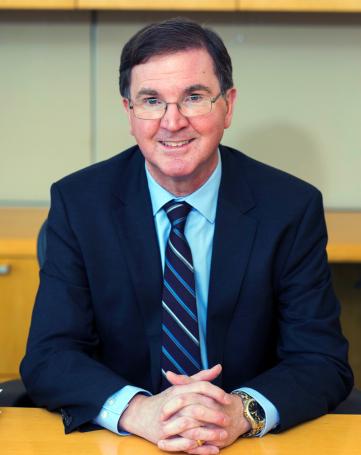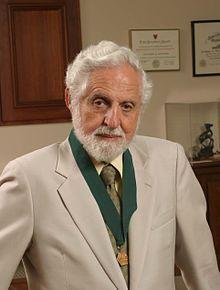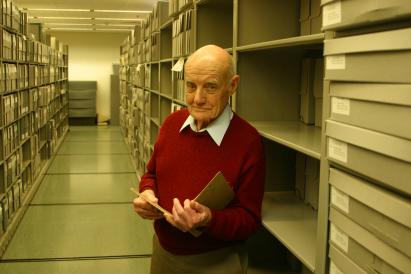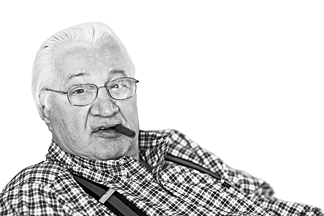
Richard van Breemen
[The end of 2018 will mark the conclusion of Richard van Breemen’s first year as director of the Linus Pauling Institute at Oregon State University. Recently, the Pauling Blog sat down with Dr. Van Breemen to learn more about his scientific background, his career in research, and his vision for LPI.
Today’s post, which is part 1 of 3, focuses on his early years and his connections with Linus Pauling. The transcript that follows has been lightly edited for clarity and continuity.]
Early Years
Pauling Blog: Tell us about your earliest interests in science.
Richard van Breemen: I come from a family with a fairly substantial scientific background. My grandfather on my mother’s side came from a homesteader family in Iowa. He was the first in his family to go to college, and he went to the University of Iowa in Iowa City, stayed on there, got an early PhD in Physiology, became a faculty member, and eventually the department head of Physiology at the University of Iowa. My mother and father met each other at Iowa in graduate school; my father became a university professor as well. I moved around the country a little bit with him; he was at the University of Colorado and eventually became head of the Biology department at a state teacher’s college in Maryland called Salisbury University. So I’m a third-generation university professor.
So growing up, there was always science around the house. My mother got me and my brothers involved actively in the 4-H program in rural Maryland where we were, on the eastern shore. I had a county award-winning insect collection; I was learning about etymology at an early age. We had shell collections from coasts around the country. So there were lots of science projects going on around me; my parents made it a very rich environment in that sense. I’m very thankful to them.
PB: Can you tell us how this progressed? The progression of your scientific interests through your high school and undergraduate years?
RVB: In high school, I also developed an interest in music. I’ve found that quite a few scientists have also been interested in music over the years, so maybe there’s some part of the brain that is both music and science together. So I applied to colleges to be either an oboist, as an obo major, or as a physicist, a physics major. I chose Oberlin College because it offered both music conservatory and a strong science academic program.
I didn’t intend to major in chemistry, but I thought it was a good idea to take some first-year, maybe even second-year organic chemistry courses. Multiple times during my first semester of chemistry as an undergrad, Norman Craig, my teacher, said, “I’ll say this only once, because I hear some of you are still learning this in high school chemistry: this is 19th century and it’s wrong.” And every time he said that, that was exactly what I learned in high school chemistry. So I was intrigued by that.
By the end of my first semester, I was a chemistry major. So thereafter I talked with my advisor in school about a path to follow; what I was interested in doing. I wanted to merge chemistry with biology. Today we call that chemical biology, and there’s departments of this, like at Harvard and other schools around the country; departments of Chemical Biology. But that’s what I wanted to do back in the 1970s, and so I was steered towards a track – “maybe look into pharmacology or toxicology.”
PB: And then what happened?
RVB: Well, I went to the University of Iowa, where I had some family ties, and spent the summer as a junior working in a pharmacology laboratory. I was introduced to an analytical tool called a mass spectrometer and I was pretty much hooked on it from then on. Today, one of my hats is biomedical mass spectrometrist. So that was the beginning of that program.
So when it came time to apply to graduate school, I applied to schools of Toxicology and Pharmacology, and chose to go to Johns Hopkins University, in the Pharmacology program. At that time, and to this day, Pharmacology at Johns Hopkins has a very strong chemistry focus. I chose an advisor, Catherine Fenselau, who had been a student of Carl Djerassi at Stanford. Djerassi is a famous chemist, connected with the invention and early development of oral contraceptive pills. So what Catherine Fenselau did in Djerassi’s lab was to introduce him to the analytical tool of mass spectrometry, which he vigorously pursued for many years thereafter. Catherine moved from Stanford eventually to Johns Hopkins University, in Pharmacology, in 1967, and brought into that medical school, for the first time, mass spectrometry. I became her first graduate student at Johns Hopkins. So in a sense, I trace my lineage to Carl Djerassi; like my grandfather in graduate education.

Carl Djerassi
So in that context, I learned about drug metabolism, analytical chemistry, in terms of how it can help solve chemical structures for new chemical entities, but also to follow how molecules change in the body. Mass spectrometry is also quantitative, and it shows you how much of a compound might be in blood or tissue. To this day, I use that as a tool for all of my research.
PB: The tool has changed a fair amount, I have a feeling.
RVB: In the 1980s, as a graduate student, mass spectrometry was a very exciting time. I tell the story to my students about how there have been three eras of mass spectrometry. The first one was the era of the physicists, using and inventing mass spectrometry to prove the existence of isotopes of the elements. Second era was the organic era, and that was championed by people like Carl Djerassi, Klaus Biemenn, and others who showed how mass spectrometers could be used to determine structures of organic molecules. At the end of each of these eras, professors were telling their students: “Don’t go into mass spectrometry, the field is done.” Physicists told their students back in the 1940s, “We’ve identified all the elements, all the isotopes. Don’t get involved in this field.” And then, by the end of the 1970s, organic chemists were telling their students, “Don’t get involved in mass spectrometry, because we know everything there is to know about the interpretation of mass spectrum that has application to organic molecules.”
Then, as a graduate student, new techniques were introduced to ionize macromolecules, to make proteins of sixty-thousand, a hundred-thousand molecular weight gas phase ions that could be manipulated in the vacuum of a mass spectrometer and measured, and the structures determined. So we’re still in that era of biomedical mass spectrometry, which has been the subject of Nobel Prizes for people like Koichi Tanaka and John Fenn, who shared the Nobel Prize for applying mass spectrometry to protein structure determinations and weighing them.

John Fenn visiting the Oregon State University Libraries Special Collections storage stacks, 2012.
PB: What was your sense of Linus Pauling when you were a student?
RVB: Well, I was aware of Linus Pauling for that fabulous chemistry textbook that he had written for undergrads, but also for his work with the structure of proteins and the alpha helix and crystallography; with x-ray crystallography of protein structures. So the chemical bond, in his work, was structures of macromolecules.
And of course I grew up in an era where, in public school, we were told to hide under our desks or go into the hall in case there was a nuclear strike, and so Pauling’s work to stop the proliferation of nuclear weapons and halt the atmospheric testing of nuclear weapons was something I was very aware of in the early 1960s. And one could think of that as sort of the next stage of his career, when he became an activist in world peace.
Of course now, in the Linus Pauling Institute, I’m realizing that the last stage of his scientific career, where he was involved with how natural products – vitamins, minerals, micronutrients – can help maintain health and prevent disease; that’s something he was very active with from the 1970s until he passed away in the 1990s.
Meeting Linus Pauling
PB: You met Pauling, did you not? When you were at NC State?
RVB: Yes, I did. This was during my very first year, and in my first academic job as an independent assistant professor. The department of Physics at North Carolina State continues to have an endowed lecture program, and they invited Pauling to give a lecture in the fall of 1986, and I was lucky enough to not only attend this lecture but to go to a reception in his honor, to get a chance to talk to Pauling for five or six minutes on my own. I was mainly asking him about – he was passionate about teaching, educating new generations of young people, undergraduate teaching, as well as graduate education. I was teaching organic chemistry for the very first time, and some of my colleagues were skipping the chapter of organic chemistry books that deals with spectroscopic characterization and the identification of organic molecules – that includes mass spectrometry, as well as nuclear magnetic resonances, infrared spectroscopy, ultraviolets spectroscopy, and so on. It was optional.
So I wanted to teach it. Not all of my colleagues were, because they wanted to spend more time on the other chapters. We all had to start with the same textbook and the same chapter and finish by the end of the semester on the same chapter, but in between we were free to teach however we felt best. So I included that chapter on spectroscopy and the determination of organic chemical structures. Pauling said that was just fine and in his chemistry textbooks, he told me he had a chapter describing mass spectrometry too, so he thought that I should follow my heart on that one. I didn’t think to ask him about his Linus Pauling Institute. Of course I couldn’t have known where I would be all these years later, but if I had, I would’ve asked him more about that aspect of his career, and what he was doing in his Institute at that time. His lecture was actually about the structures of certain kinds of crystals-a physics lecture, in this particular case [on quasicrystals].
A Pauling Research Connection
RVB: With Norman Farnsworth, who has now passed away, but was a very esteemed, world-famous pharmacognosist, we founded the first NIH-funded botanical center for dietary supplements research in 1999. That grew out of the Dietary Supplement Health Education Act, known as DSHEA, of 1994. And here’s a Pauling connection.

Norman Farnsworth
In the 1970s, when Linus Pauling got to being very active in research with vitamin C and cancer prevention, there was a move by the Food and Drug Administration, and by Congress, to regulate vitamin C and other vitamins as potential drugs or therapeutic agents. Pauling argued, testified before Congress, worked very diligently, to help keep vitamins and mineral supplements over-the-counter. He felt that that these compounds were so safe that it wasn’t necessary to make them prescription-only. First, he advocated for larger doses of Vitamin C than was necessary to prevent scurvy, but that’s the whole area of research that became the Linus Pauling Institute.
So he was successful, Congress only passed laws that helped regulate the amounts of certain nutrients and for the most part vitamins and mineral supplements remain over-the-counter…of course, there are prescription medicines for pregnant women who need extra vitamins during the prenatal period.
Skip ahead twenty years to the 1993-94 period of time, and Congress revisited whether dietary supplements should be regulated in a new and different way. This was towards the end of Linus Pauling’s career – or, his whole life – but he still weighed in on this. And I was just checking some of the facts and figures in this archive here at the Oregon State University Library, and Pauling did have written into the Congressional Record some of his opinions regarding the possible regulation or why dietary supplements should not be overly regulated, and I think he had another major effect because people listened to him in Congress.
And I think what came out of that period of Congressional hearings was the Dietary Supplement Health Education Act of 1994, which created a niche market for dietary supplements: they are neither drugs and regulated by prescription, nor are they foods, which has a whole different set of regulations. But it did authorize the Food and Drug Administration and the Federal Trade Commission to regulate what’s on the label, and to act if anything was being marketed that was harmful. The FDA has since issued a regulation that requires dietary supplements to be produced using good manufacturing practice. That wasn’t initially part of their regulations, but that has been added since.
So part of the DSHEA Act was to establish the Office of Dietary Supplements within the NIH – ODS – and gave them money by statute to investigate the safety and efficacy of botanical dietary supplements with the mission of protecting the health of the consumer. And by 1999, the very first grant out of that Office of Dietary Supplements was issued, and there were two grants funded that year, one to University of Illinois at Chicago, where I was, working with Norman Farnsworth, and the other to UCLA. That program has continued to this day, and when I left the University of Illinois at Chicago, I was the director of that botanical center. I wasn’t able to move it to Oregon State University, but the grant continues, and I continue to work with them, running a project in an analytical core to support the work that we began in 1999, looking at the safety and efficacy of botanical dietary supplements used by women.
So there’s a little overlap with Linus Pauling and the work I was doing in Chicago before coming here.
Pauling’s Enduring Legacy
PB: What is your sense of Linus Pauling’s legacy today?
RVB: Well, Pauling’s legacy, it continues in many, many ways. He, of course, received his first Nobel Prize for his work on the chemical bond, using a synthesis of theory and laboratory experiment to prove what the nature of the sigma bond is between atoms, like two carbons. All of chemistry today owes him a lot in that sense; he was extremely brilliant in many respects, he thought ahead. When I talked with him at that brief meeting during his lecture in North Carolina, he told me he was writing his next paper in the back of his mind as we were speaking. But he typically would write a paper, have all the aspects of it worked out in his mind, before sitting down with a typewriter.
He obviously had a lot of things going on at any one time. He was ahead of his time in his efforts to contain nuclear weapons – I think most of the world caught up later to realize how important that work was, in leading to the test ban treaty.
I think the work that began the Linus Pauling Institute was also well ahead of its time. He certainly received a lot of criticism. I think folks in biomedical research might’ve circled their wagons and said, “well, you’re a chemist, what do you know about cancer and cancer prevention?” But in many respects, he was ahead of his time there, and we now know, not only can vitamins prevent the diseases of malnutrition, but they do have benefits beyond simply keeping all of the biochemical pathways working. So to say that vitamin C has no benefits at all as supplements, of course, wouldn’t be true, because it prevents the disease of scurvy, and then there’s rickets and other vitamin deficiency diseases. So we definitely know that vitamins are essential for human health. The question is, what’s the optimum for human health? And that’s something that the Linus Pauling Institute began exploring and, to this day, we are continuing to work on that.
